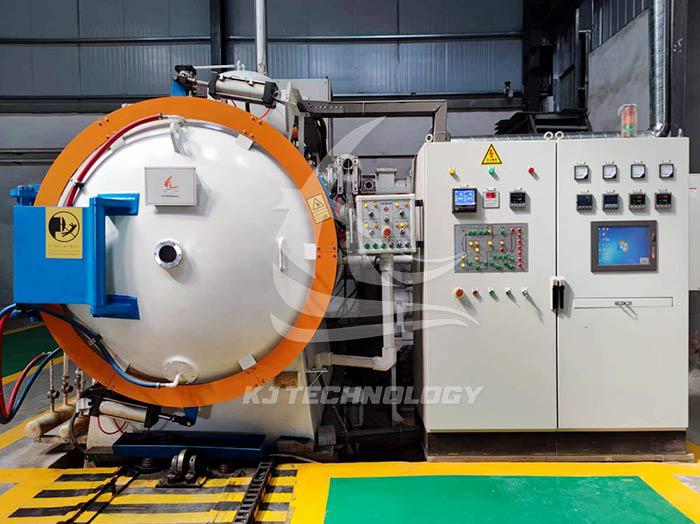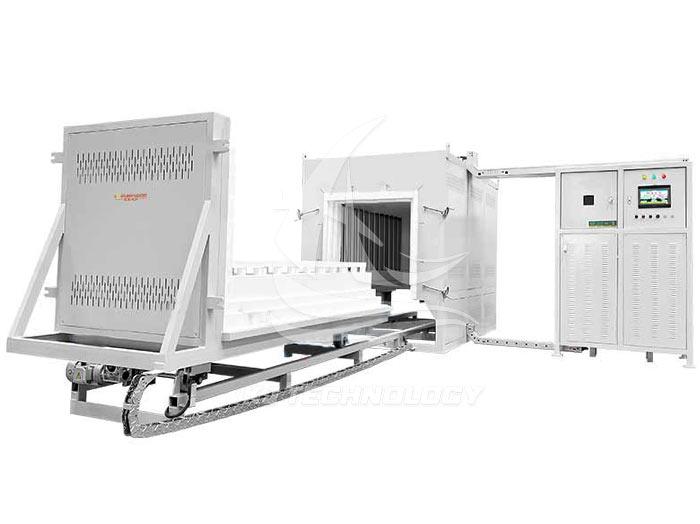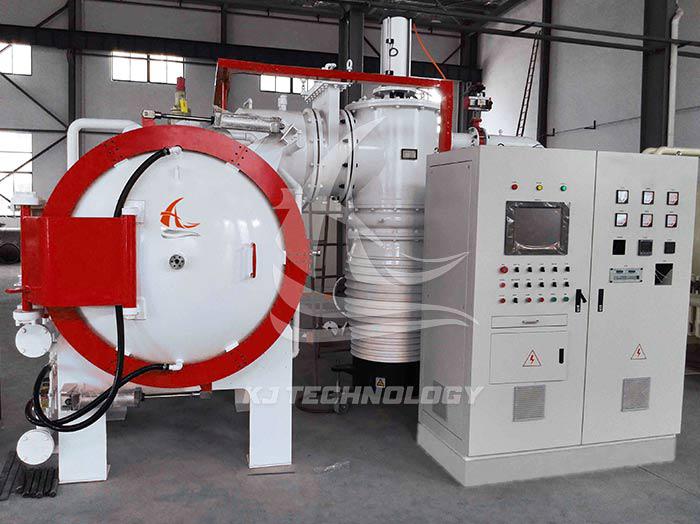Precautions for operating vacuum degreasing furnace
 08-22-2025 Author: KJ technology
08-22-2025 Author: KJ technology
The operation of the vacuum degreasing furnace must strictly follow safety regulations and technical requirements, involving multiple aspects such as equipment preheating, vacuum control, temperature management, process execution, and safety protection. The following are detailed operational precautions, covering key points before, during, and after the operation:
1. Preparation before operation
Equipment inspection
Appearance inspection: Confirm that the furnace body, vacuum pump, heating element, thermocouple and other components are not damaged, loose or leaking.
Electrical inspection: Check whether the power supply line, grounding wire, and circuit breaker are normal to avoid the risk of short circuit or leakage.
Vacuum system inspection: Check the oil level and quality of the vacuum pump (whether it is emulsified or contaminated) to ensure that there is no air leakage in the pump body; Test the accuracy of instruments such as vacuum gauges and pressure sensors.
Cooling system inspection: Confirm that the cooling water circulation is normal, the water temperature and flow rate meet the requirements, and avoid damage to the heating elements due to insufficient cooling.
Workpiece preparation
Cleanliness: The surface of the workpiece should be free of oil, dust, or impurities to avoid secondary pollution or affecting the vacuum degree during the degreasing process.
Loading capacity: Control the loading capacity of workpieces to avoid excessive accumulation that may cause uneven temperature fields or poor gas emissions.
Placement method: The workpieces should be evenly distributed inside the furnace, avoiding obstruction of heating elements or thermocouples to ensure accurate temperature measurement.
Confirmation of process parameters
Set a reasonable process curve based on the workpiece material (such as metal, ceramic, composite material) and degreasing requirements (such as degreasing temperature, time, vacuum degree).
Confirm parameters such as heating rate, insulation time, and cooling method to avoid deformation or performance degradation of the workpiece due to parameter errors.
2. Precautions during operation
Vacuum pumping stage
Pre vacuum pumping: First, start the mechanical pump (such as the rotary vane pump) for pre pumping to reduce the pressure inside the furnace to below 10 ³ Pa, and then start the molecular pump or diffusion pump for high vacuum pumping.
Vacuum monitoring: Real time observation of vacuum gauge readings to ensure that the vacuum level meets the process requirements (such as below 10 ⁻ ³ Pa). If the vacuum degree rises slowly or cannot reach the set value, it is necessary to check the sealing of the furnace body or the performance of the vacuum pump.
Gas replacement: If it is necessary to remove adsorbed gases (such as water vapor and oxygen) from the workpiece, inert gases (such as nitrogen and argon) can be filled multiple times after vacuuming to reduce the impact of residual gases on the degreasing effect.
heating phase
Segmented heating: Adopting a stepped heating method to avoid excessive thermal stress on the workpiece or overload of the vacuum pump caused by rapid heating.
Temperature uniformity: Monitor the temperature at different positions inside the furnace through thermocouples or infrared thermometers to ensure the uniformity of the temperature field. If the temperature deviation is too large, it is necessary to adjust the power of the heating element or optimize the placement of the workpiece.
Power control: dynamically adjust the heating power based on the feedback of the vacuum degree and temperature inside the furnace, to avoid excessive power leading to enhanced gas convection inside the furnace and affecting the vacuum degree.
Degreasing stage
Gas emissions: During the degreasing process, organic matter (such as grease and wax) in the workpiece will evaporate into gas, which needs to be promptly discharged through a vacuum pump. If gas emissions are not smooth, it may cause an increase in furnace pressure or contamination of the workpiece surface.
Pressure monitoring: Maintain stable pressure inside the furnace to avoid excessive pressure fluctuations that may cause deformation of the workpiece or incomplete degreasing. If the pressure suddenly increases, stop heating immediately and check the vacuum system.
Time control: Strictly control the degreasing time according to the process requirements to avoid incomplete degreasing due to insufficient time or decreased workpiece performance due to prolonged time.
cooling stage
Cooling method: Select the appropriate cooling method based on the workpiece material (such as natural cooling, gas filled cooling, water cooling). If rapid cooling is required, it is necessary to ensure that the cooling gas (such as nitrogen) is dry and oil-free to avoid contaminating the workpiece.
Temperature monitoring: Continuously monitor the temperature inside the furnace during the cooling process to avoid sudden drops in temperature that may cause cracking or deformation of the workpiece.
Vacuum maintenance: If it is necessary to maintain the vacuum state in the furnace for cooling, it is necessary to ensure that the vacuum pump continues to operate to avoid air entering and causing oxidation of the workpiece.
3. Post operation maintenance
Cleaning inside the furnace
After degreasing is completed, promptly clean the residue inside the furnace (such as degreasing products, dust) to avoid contaminating the workpiece or affecting the vacuum degree during the next use.
Use a dust-free cloth or specialized cleaning tool to wipe the interior of the furnace to avoid scratching the inner walls or damaging the heating elements.
Equipment Maintenance
Vacuum pump maintenance: Regularly replace the vacuum pump oil, clean the inside of the pump body, and check whether the seals are aging or damaged.
Heating element inspection: Check whether the heating element (such as resistance wire, graphite rod) is oxidized or broken, and replace it if necessary.
Thermocouple calibration: Regularly calibrate thermocouples to ensure temperature measurement accuracy.
Cooling system inspection: Clean the cooling water pipeline, check if the water pump and valves are working properly, and avoid scale blockage or water leakage.
safety protection
Personal protection: Wear protective gloves, goggles, and gas masks (if degreasing products are toxic) during operation to avoid high temperature burns or inhalation of toxic gases.
Equipment protection: Set up protective barriers or warning signs around the furnace body to prevent unrelated personnel from coming into contact with high-temperature components or accidentally operating the equipment.
Emergency response: Familiarize oneself with the location of emergency stop buttons on equipment, and master emergency response methods for sudden situations such as fires and electrical leaks.
4. Common Problems and Solutions
Insufficient vacuum degree
Reason: Poor sealing of the furnace body, decreased performance of the vacuum pump, and excessive volatilization of gas from the workpiece.
Solution: Check if the sealing rings of the furnace door and observation window are aging; Replace the vacuum pump oil or repair the pump body; Optimize the degreasing process to reduce gas evaporation.
The temperature cannot rise
Reason: Heating element damage, power failure, thermocouple position deviation.
Solution: Replace the heating element; Check the power supply circuit; Re calibrate the thermocouple position.
Workpiece deformation or cracking
Reason: Excessive heating rate, improper cooling method, and excessive internal stress on the workpiece.
Solution: Adjust the heating rate and adopt segmented heating; Optimize cooling methods (such as slow inflation cooling); Pre treat the workpiece (such as stress relief annealing).








